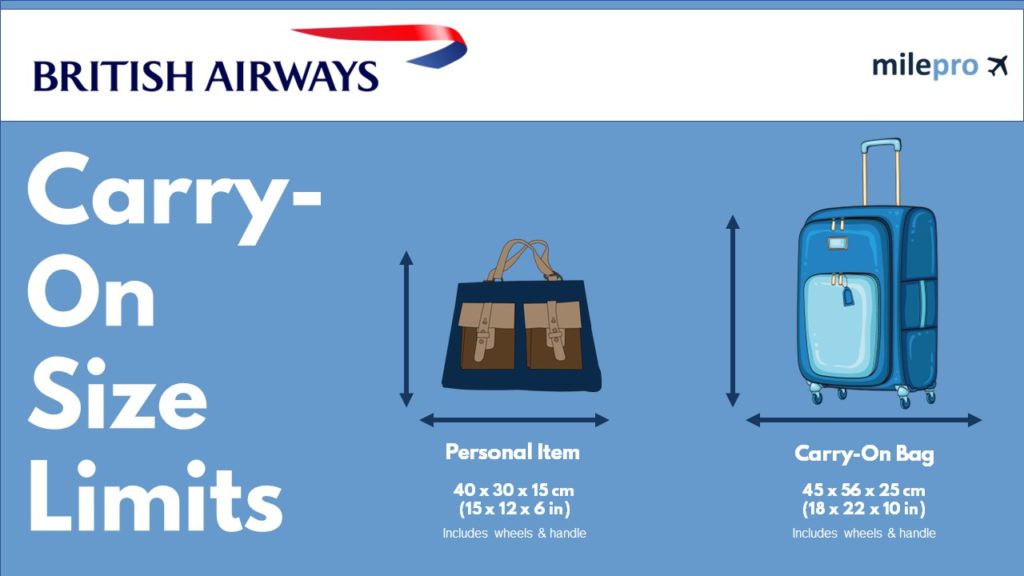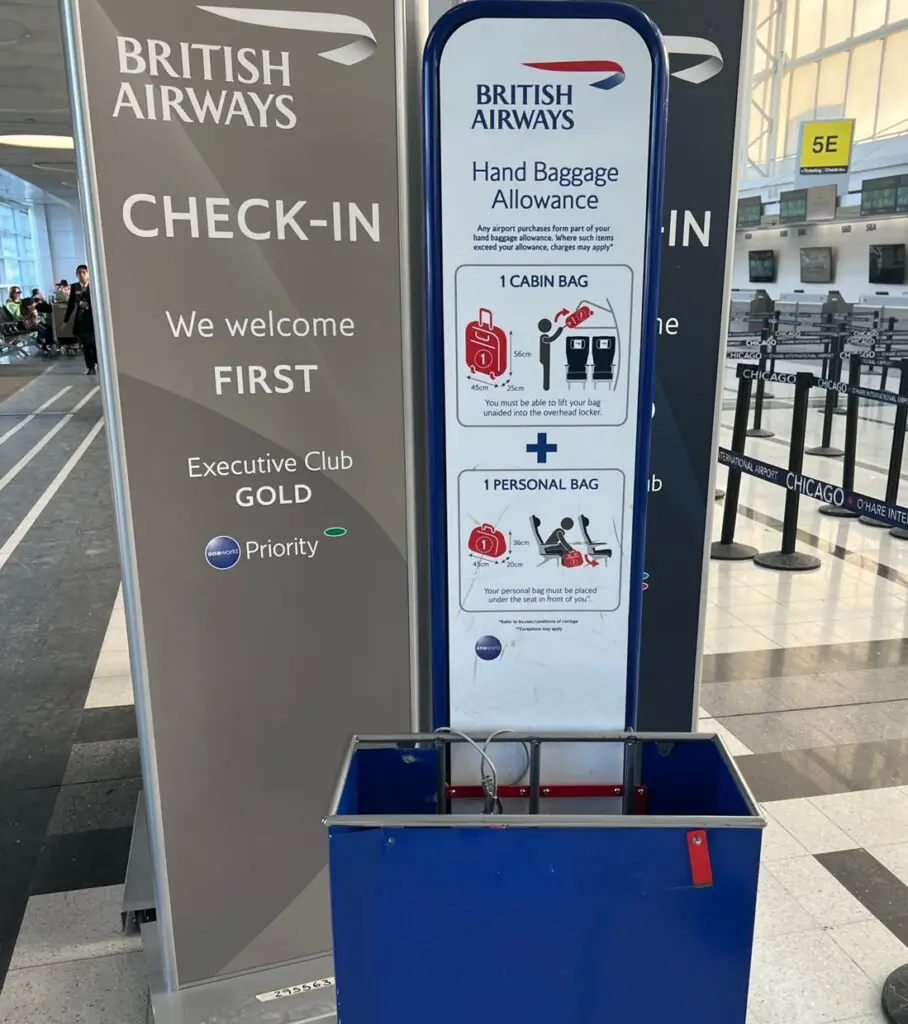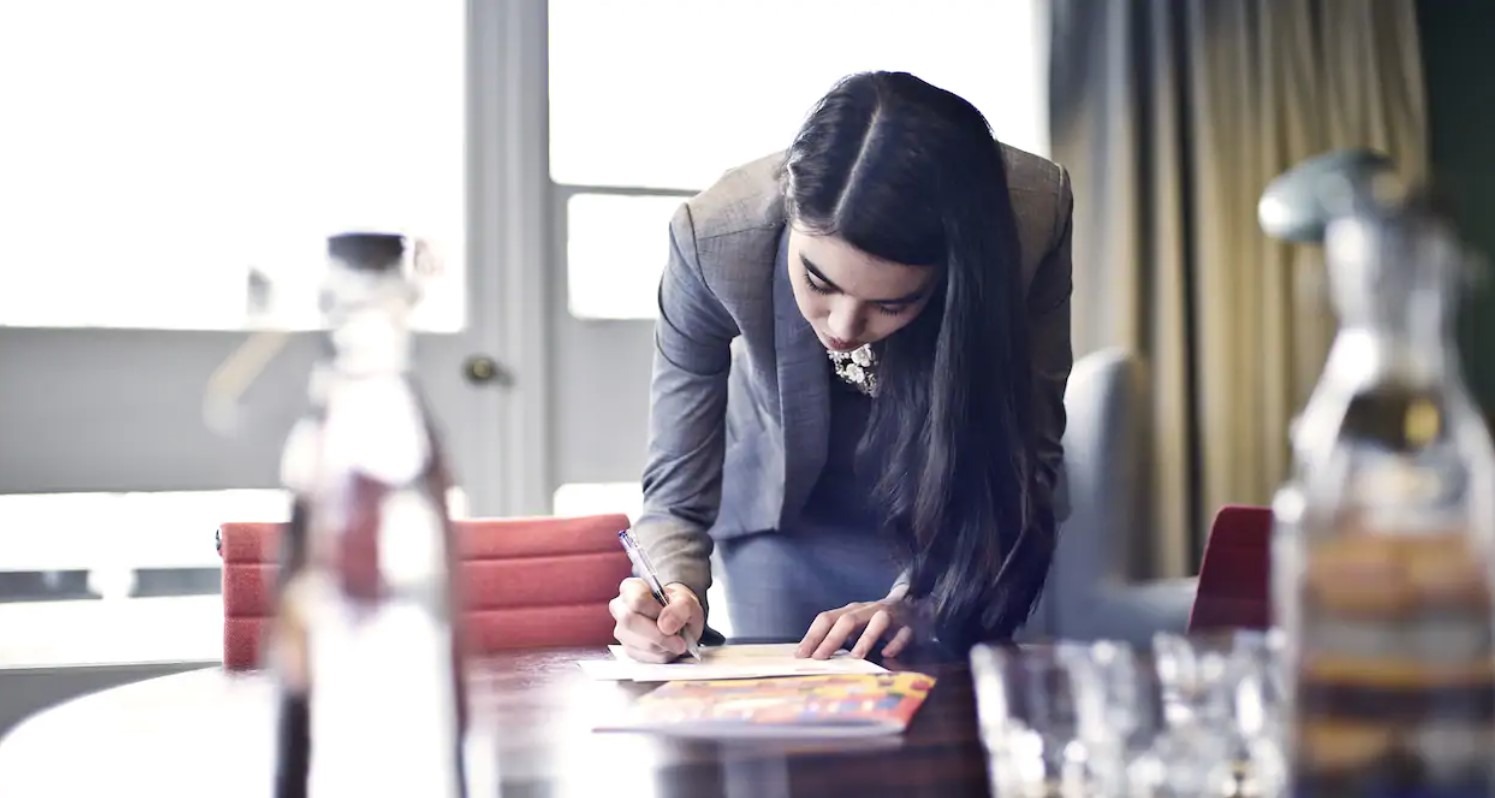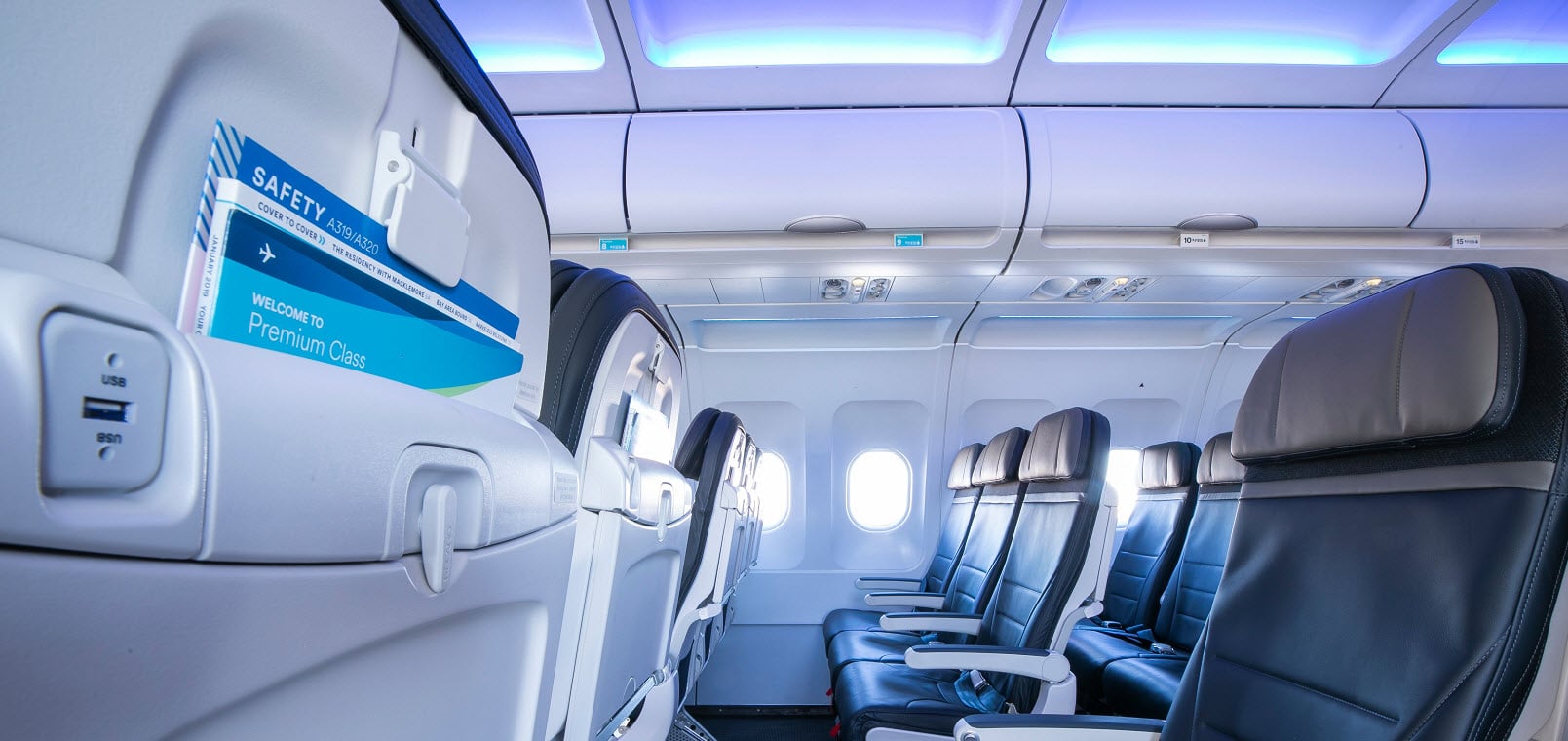Table of Contents[Hide][Show]
If you’re planning to travel with just a carry-on, you’ll need to be up to speed with airline carry-on policies. Specifically, the various rules and regulations each carrier has for what you can and cannot “carry on” to the plane. Each airline’s rules are different, so don’t just assume that what works for one will work for all airlines.
If you are going to be flying British Airways, they have very specific guidelines for carry-on sizes, liquids, and other unique items that you may want to bring on board.
In this article, we’ll explain everything you need to know about British Airways’ carry-on restrictions. This includes their carry-on size and weight limits, personal items, liquids, pets, prohibited items, and other rules and restrictions you should know before boarding your flight.
British Airways Carry-On Size and Weight Policy
British Airways allows one carry-on bag (“Cabin Bag”) and one personal item (“Hand Bag”) onboard at no charge.

British Airways Carry-On Size (Dimensions)
British Airways’ size restrictions for carry-on baggage are 22 x 18 x 10 inches ( 56 x 45 x 25cm).
If you are not sure what size your carry-on is, British Airways does provide size check templates located at their ticket counters and gates. But by the time you get to either of these locations, it’s too late if the bag is too big, so better always to know your bag size in advance.
British Airways carry-on size limits are displayed when you check-in
British Airways Carry-On Weight Limit
British Airways requires carry-on bags to weigh less than 23 kg (51 lbs.). However, they don’t weigh your carry-on items prior to boarding, so you’re generally not going to have a problem if it’s too heavy. The weight issue applies to check baggage more than carry-on bags since they weigh your checked bags when you check in for your flight.
Recommended Carry-On Bag
If you are looking for an international-sized carry-on bag, the Travelpro 20-inch Global Expandable Spinner Carry-on is definitely one to consider. It’s durable, reasonably priced, and holds enough for shorter trips (3-5 days). Plus the spinner wheels make it very easy to get through the airport quickly and effortlessly.
Rules for Small Regional Aircraft
If you are flying one of British Airways’ regional planes, such as an Embraer 190, it may not be possible to carry your hand baggage on board, even if it has the correct dimensions and weight. If this is the case, BA will check it in and carry it in the hold, free of charge.
If you want to make sure you have a bag that will fit, check out this article on the best carry-on bags for regional jets.
British Airways Personal Item Size
Personal items include a purse, briefcase, laptop, backpack, shopping bag, or a similar-sized item. They can have a maximum weight of 23kg (51lbs.) and up to 40 x 30 x 15cm (16 x 12 x 6 inches)
Additional items that can be carried on include:
- A jacket and/or umbrella
- Food or drink purchased after clearing the security checkpoint
- Duty-free merchandise
- Special items like strollers, child restraint seats, or assistive devices such as wheelchairs or crutches
British Airways Carry-On Liquid Policy
The rules for carry-on liquids are set by the TSA in the US and the EASA and European Commission in Europe. British Air doesn’t have its own specific Liquids Policy, they just enforce the rules and policies of the Authorities.
- Containers with liquids and gel-like substances may hold up to 100 ml (maximum capacity must be printed on the container).
- All containers must be carried in a plastic bag (transparent, resealable, max. capacity of 1 liter). One bag per person.
- The bag must be presented separately at security. Take your liquids out of your carry-on baggage at the security screening point and present them separately. In exceptional cases, liquids may be opened in the course of security checks and removed from their outer packaging.
- Liquid duty-free goods purchased at an international airport or on board an aircraft outside the EU must be transported in a tamper-proof, certified bag on connecting flights via an EU airport. The proof of purchase must be inside the bag and the bag must be sealed by the retailer.
- Medicines and special food (e.g. baby food) can be carried outside the plastic bag and must also be presented at security.
Below is a table that provides some examples of Non-solid Food and Personal Items that are considered “liquids”:
| Liquids | Food | Aerosols | Gels |
| Beverages | Jelly | Spray Paint | Hair Gel |
| Shampoo | Pudding | Deodorant Spray | Shower Gel |
| Conditioner | Yogurt | Insect Repellent | Hand Sanitizer |
| Toothpaste | Gelatin | Cooking Spray | Gel Deodorant |
| Lotion | Mashed Potatoes | Sunscreen | |
| Mouthwash | Peanut Butter | Spray Lubricant | |
| Liquid soap | Cheese Spread | Hairspray | |
| Contact Lens Solution | Maple Syrup | Shaving Cream | |
| Perfume | Hummus |
The TSA 3-1-1 Rule
Each passenger may carry liquids, gels, and aerosols in travel-size containers that are 3.4 ounces or 100 milliliters and are enclosed in a sealed, one-quart-size bag. Common travel items that must comply with the 3-1-1 liquids rule include toothpaste, shampoo, conditioner, perfume, mouthwash, deodorant, and lotion.
Any liquid that does not meet the TSA 3-1-1 rule will either have to be checked with your luggage or will be thrown away at the security checkpoint.
Exceptions to this rule are certain medications and baby food/child nourishment.
Carry-On Food
The TSA also sets the rules for what type of food you can bring on the plane. There are two different scenarios pertaining to food:
- The food you bring with you from home, and
- The food you buy at the airport after you have gone through security.
When bringing food with you from home, an important thing to note is the classification of liquid vs. solid foods.
The general rule is “If you can spill it, spread it, spray it, pump it, or pour it, then it’s considered a liquid or gel.” This means your food may be considered a liquid and will fall under the TSA 3-1-1 liquids rule, which mandates that any liquid, gel, cream, aerosol, or paste in a carry-on must be 3.4 ounces or less, and fit in one quart-size resealable bag (only one such bag is allowed per passenger).
Here’s a link to the TSA website advising what food can be brought with you on your British Airways flight. This applies to food you are bringing from home through security. Once you get through security, you can bring just about any food on the plane that you buy at the airport.
British Airways Pet Policy
As a general rule, British Airways does not allow pets, including emotional support animals, in the main cabin, they must travel in the holding area. However, they will allow recognized service dogs to travel with you.
Prohibited Items and Dangerous Goods
There are certain items that are considered dangerous and classified as a hazardous material. Dangerous goods are prohibited from both your carry-on and checked bag on all flights. These rules are not specific to any airline and are mandated by the Federal Aviation Administration.
Items considered “dangerous goods” are prohibited under British Airways’ carry-on policy and include the following:
- Firearms and ammunition
- Stunning devices, mace, tear gas, and pepper spray
- Poisonous, infectious, or radioactive substances
- Sharp or pointed objects (knives, swords, cutting instruments, razors, ice skates, carpet knives, metal scissors, box cutters, or similar items)
- Camping equipment containing flammable liquids or gasses
- Flammable liquids, including gasoline and kerosene
- Self-Balancing devices such as hoverboards, including electric skateboards, balance boards, and gravity boards
- Medical or liquid oxygen
- Torch lighters, lighter fluid, strike-anywhere matches, and fire starters
- Wet-cell batteries
The following items are not considered “dangerous goods” and are allowed when packaged properly, in accordance with FAA regulations
- Hiking or trekking poles
- Hair dryer/Straightener
- Hair spray
- Sunscreen/bug spray
- Food as a carry on
- Fishing hooks
- Fragile glass items
A complete list can be found on the FAA website and the TSA website.
One more way to find them is with the British Airways summary of restricted items.
British Airways Carry-On Size and Fees
British Airways does not charge a fee for carry-on baggage that meets their size requirements. If your bag is too large and does not meet British Airways’ carry-on restrictions, you may be charged a fee to gate-check it.
Here is a link to British Airways’ Carry-On page to ensure you have the most up-to-date information.






 Hyatt Employee Discounts + Friends & Family Rates – Everything you need to know!
Hyatt Employee Discounts + Friends & Family Rates – Everything you need to know!
Do medications need to be left in the original bottles? Or can we take a picture of the medications in their original bottles but put pills in ziploc bags?
Medications do not have to be left in their original bottles, just make sure you adhere to the TSA 3-1-1 rule.
https://milepro.com/the-tsa-liquids-rule/